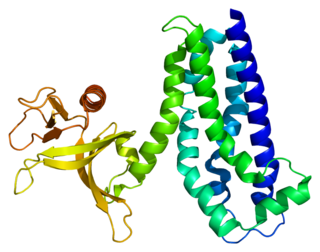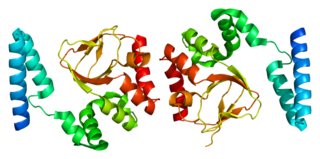Potassium/sodium hyperpolarization-activated cyclic nucleotide-gated ion channel 2 is a protein that in humans is encoded by the HCN2 gene. [5] [6] [7] [8]
Potassium/sodium hyperpolarization-activated cyclic nucleotide-gated ion channel 2 is a protein that in humans is encoded by the HCN2 gene. [5] [6] [7] [8]
HCN2 has been shown to interact with HCN1 [9] [10] and HCN4. [9]
The function of the channel is not known although its activation by hyperpolarization alludes to the funny channels in the sinoatrial node of the heart (which form the basis of spontaneous generation of electrical rhythm). These channels have recently been associated with chronic pain and blocking the gene is associated with resolution of neuropathic episodes of pain. [11]

Cyclic nucleotide–gated ion channels or CNG channels are ion channels that function in response to the binding of cyclic nucleotides. CNG channels are nonselective cation channels that are found in the membranes of various tissue and cell types, and are significant in sensory transduction as well as cellular development. Their function can be the result of a combination of the binding of cyclic nucleotides and either a depolarization or a hyperpolarization event. Initially discovered in the cells that make up the retina of the eye, CNG channels have been found in many different cell types across both the animal and the plant kingdoms. CNG channels have a very complex structure with various subunits and domains that play a critical role in their function. CNG channels are significant in the function of various sensory pathways including vision and olfaction, as well as in other key cellular functions such as hormone release and chemotaxis. CNG channels have also been found to exist in prokaryotes, including many spirochaeta, though their precise role in bacterial physiology remains unknown.
The pacemaker current is an electric current in the heart that flows through the HCN channel or pacemaker channel. Such channels are important parts of the electrical conduction system of the heart and form a component of the natural pacemaker.

Rap guanine nucleotide exchange factor 3 also known as exchange factor directly activated by cAMP 1 (EPAC1) or cAMP-regulated guanine nucleotide exchange factor I (cAMP-GEFI) is a protein that in humans is encoded by the RAPGEF3 gene.

G protein-activated inward rectifier potassium channel 4 is a protein that in humans is encoded by the KCNJ5 gene and is a type of G protein-gated ion channel.

Chloride channel protein 2 is a protein that in humans is encoded by the CLCN2 gene. Mutations of this gene have been found to cause leukoencephalopathy and Idiopathic generalised epilepsy, although the latter claim has been disputed. CLCN2 contains a transmembrane region that is involved in chloride ion transport as well two intracellular copies of the CBS domain.

ATP-sensitive inward rectifier potassium channel 12 is a lipid-gated ion channel that in humans is encoded by the KCNJ12 gene.

Cyclic nucleotide-gated cation channel alpha-3 is a protein that in humans is encoded by the CNGA3 gene.

Triple functional domain protein is a protein that in humans is encoded by the TRIO gene.

Cyclic nucleotide-gated channel alpha 1, also known as CNGA1, is a human gene encoding an ion channel protein. Heterologously expressed CNGA1 can form a functional channel that is permeable to calcium. In rod photoreceptors, however, CNGA1 forms a heterotetramer with CNGB1 in a 3:1 ratio. The addition of the CNGB1 channel imparts altered properties including more rapid channel kinetics and greater cAMP-activated current. When light hits rod photoreceptors, cGMP concentrations decrease causing rapid closure of CNGA1/B1 channels and, therefore, hyperpolarization of the membrane potential.

Potassium/sodium hyperpolarization-activated cyclic nucleotide-gated channel 4 is a protein that in humans is encoded by the HCN4 gene.

Acid-sensing ion channel 2 (ASIC2) also known as amiloride-sensitive cation channel 1, neuronal (ACCN1) or brain sodium channel 1 (BNaC1) is a protein that in humans is encoded by the ASIC2 gene. The ASIC2 gene is one of the five paralogous genes that encode proteins that form trimeric acid-sensing ion channels (ASICs) in mammals. The cDNA of this gene was first cloned in 1996. The ASIC genes have splicing variants that encode different proteins that are called isoforms.

Potassium/sodium hyperpolarization-activated cyclic nucleotide-gated channel 1 is a protein that in humans is encoded by the HCN1 gene.

Phosphatidylinositol 3,4,5-trisphosphate-dependent Rac exchanger 1 protein is a protein that in humans is encoded by the PREX1 gene.
Hyperpolarization-activated cyclic nucleotide–gated (HCN) channels are integral membrane proteins that serve as nonselective voltage-gated cation channels in the plasma membranes of heart and brain cells. HCN channels are sometimes referred to as pacemaker channels because they help to generate rhythmic activity within groups of heart and brain cells. HCN channels are encoded by four genes and are widely expressed throughout the heart and the central nervous system.

Cyclic nucleotide gated channel beta 1, also known as CNGB1, is a human gene encoding an ion channel protein.

The SCNN1D gene encodes for the δ (delta) subunit of the epithelial sodium channel ENaC in vertebrates. ENaC is assembled as a heterotrimer composed of three homologous subunits α, β, and γ or δ, β, and γ. The other ENAC subunits are encoded by SCNN1A, SCNN1B, and SCNN1G.

Cyclic nucleotide gated channel alpha 2, also known as CNGA2, is a human gene encoding an ion channel protein.

G protein-activated inward rectifier potassium channel 3 is a protein that in humans is encoded by the KCNJ9 gene.

Potassium/sodium hyperpolarization-activated cyclic nucleotide-gated channel 3 is a protein that in humans is encoded by the HCN3 gene.

cGMP-dependent protein kinase 1, alpha isozyme is an enzyme that in humans is encoded by the PRKG1 gene.
This article incorporates text from the United States National Library of Medicine, which is in the public domain.